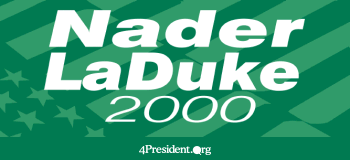In Decision ’16, former first lady Hillary Clinton had her White House bid stopped when she failed to secure enough of the vote in crucial swing states like Pennsylvania, Michigan, Ohio, North Carolina and, yes, Florida.
However, she narrowly won the popular vote on the heels of a strong showing in the northeast and on the West Coast in densely populated areas that traditionally vote Democrat. Many blame the ill-fated bids of Libertarian Gary Johnson and Dr. Jill Stein for Clinton’s loss this year.
It was eerily reminiscent of another election, back in 2000 when left-leaning activist Ralph Nader ran on the Green Party ticket and espoused a progressive platform that many believe siphoned votes away from Democrat Al Gore.
Everyone remembers the recount. Here’s what happened with Nader:
He campaigned on a leftist platform

A lot of Nader’s platform contains thoughts echoed by later progressives, such as Sen. Bernie Sanders of Vermont. Way back in 2000, he railed against he two party system and voter fraud, while promoting populist issues such as environmental justice, universal healthcare, affordable housing, tuition-free college and a federal mandate that would increase the minimum wage to a living wage.
Nader as a spoiler
Many pundits argued that, because Gore lost the election by barely more than 500 votes in Florida, the sheer amount of ballots cast in the state for Nader created a spoiler out of the liberal. More than 97,000 people voted for Nader in the Sunshine State.
Although many urged him to drop his presidential bid for fear of handing the election to Bush, Nader would go on to campaign heavily in the states of Florida, Minnesota, Michigan, Oregon, Washington and Wisconsin.

In 2016 as many voters appeared overtly dissatisfied with the choice between Clinton and Donald Trump, Nader explained his rationale for running this way:
“[Votes for a third party] are not a wasted vote at all. They get things underway that the two parties are ignoring taking off the table. The Liberty Party in 1840 that went out against slavery. The Women’s Right to Vote Parties in the mid-nineteenth century, the Farmer’s Labor Party and they never won a national election but they push the envelope of these justice pathways onto the table of one or two of the major parties. It’s decent, decent is the mother of ascent in American History.”
In the aftermath
<iframe width=”560″ height=”315″ src=”https://www.youtube.com/embed/wHNPpE2OS7k” frameborder=”0″ allowfullscreen></iframe>
Nader failed to receive the 5% of the popular vote required to get the Green Party to receive matching funds from the federal election commission in future presidential races, and his shortcomings led to speculation that his own self-interest had caused the demise of the Democrats’ chances to retain the White House and usher in the new millennium.
It is an anomaly perhaps explained best by Jim Hightower, the progressive Texan who co-chaired Nader’s campaign and once served as the Texas Ag Commissioner before losing his office to Rick Perry in the early ’90s.
“Nader only drew 24,000 Democrats to his cause, yet 308,000 Democrats voted for Bush. Hello. If Gore had taken even 1 percent of these Democrats from Bush, Nader’s votes wouldn’t have mattered. Second, liberals. Sheesh. Gore lost 191,000 self-described liberals to Bush, compared to less than 34,000 who voted for Nader.”
